Figure 1 Developing countries most affected by COVID-19
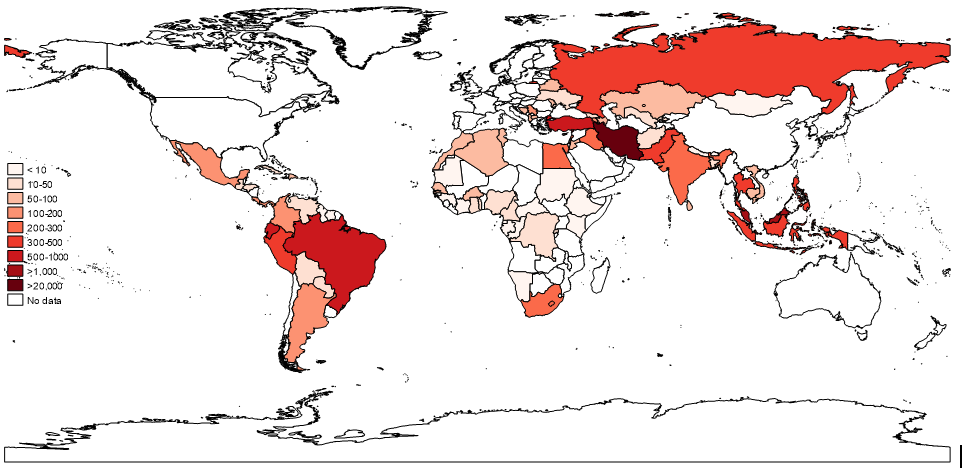 Source: World Health Organization Coronavirus disease (COVID-2019) situation report – 62 of 22 March 2020 (https://www.who.int/emergencies/diseases/novel-coronavirus-2019/situation-reports)
Source: World Health Organization Coronavirus disease (COVID-2019) situation report – 62 of 22 March 2020 (https://www.who.int/emergencies/diseases/novel-coronavirus-2019/situation-reports)
Developing countries depend on imports for critical COVID-19 products
The World Health Organization COVID-19 Disease Community Package (DCP) contains 17 products that are considered key to deal with the current crisis. They consist of essential items for diagnosis and treatment processes such as enzymes, hygiene products such as liquid soap and hand sanitizers, personal protection equipment including gloves and medical masks, and case management products such as oxygen concentrators and respirators.
The global markets for these crucial COVID-19 products are highly concentrated (Espitia et al. 2020). This is even more true when we focus on developing countries, as the large majority is highly dependent on imports for these products. For the 20 developing countries with the highest numbers of COVID-19 cases, five countries account for 80% of total imports: the EU, US, China, Japan and Korea (Figure 2). For products needed for case management and diagnostics, the shares of imports from top exporters is even higher and close to 90%. Import shares for protection equipment and hygiene products are somewhat lower, but still between 50 and 60%.
Figure 2 Main sources of critical COVID-19 products for the 20 most affected developing countries
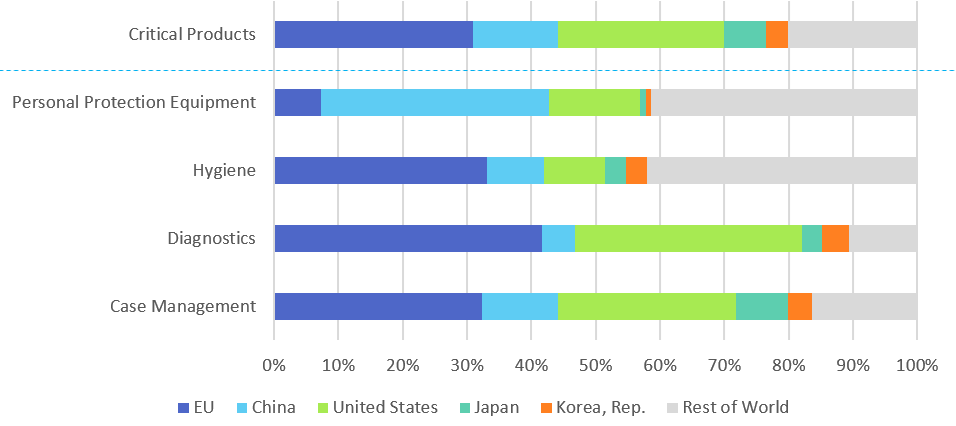 Source: Espitia et al. (2020).
Note: Total imports calculated as the average for 2017, 2018, and 2019 (in case data is available). For countries without direct trade data, mirror data are used.
Source: Espitia et al. (2020).
Note: Total imports calculated as the average for 2017, 2018, and 2019 (in case data is available). For countries without direct trade data, mirror data are used.
Export restrictions could create disruption in supplies and price increases for COVID-19 products
The high concentration of
imports in certain products makes developing countries extremely vulnerable to changes in policies by exporters. As a result of export restrictions on key COVID-19 products, access to medical supplies and other critical products could be disrupted for developing countries that need them urgently. Table 1 shows that medical masks are likely to be the product most affected by such restrictions. Venturi masks, a medical device needed to deliver oxygen to patients, are also affected by current export restrictions. In addition, individual countries will likely experience shortages of specific products, as Armenia in the case of protective clothing or Malaysia in the case of hand sanitizers. Smaller disruptions are expected on a number of products for personal protection.
Table 1 Share of imports from countries imposing export restrictions, %
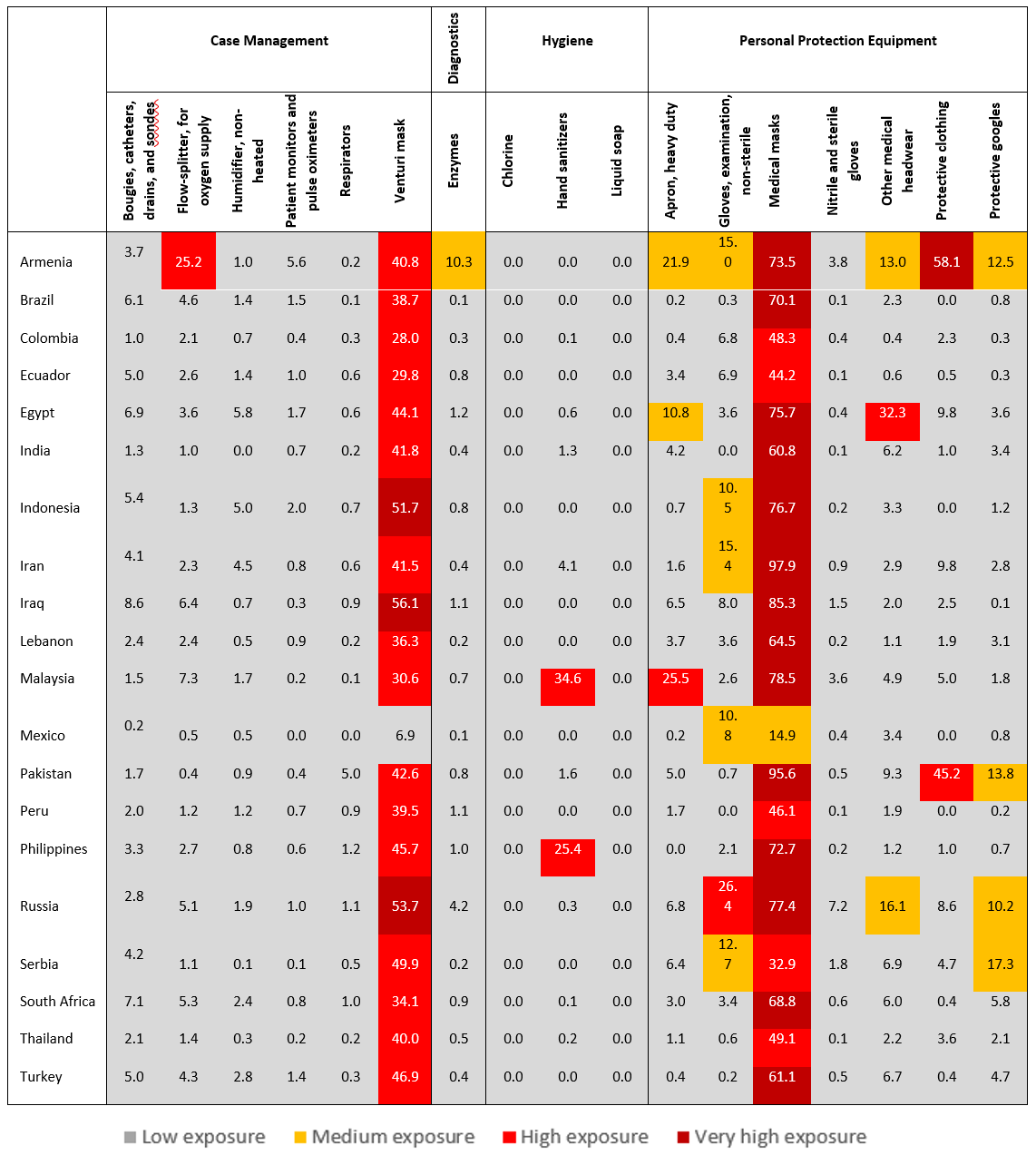 Source: Espitia et al. (2020).
Note: Total imports calculated as the average for 2017, 2018, and 2019 (in case data are available).
Source: Espitia et al. (2020).
Note: Total imports calculated as the average for 2017, 2018, and 2019 (in case data are available).
Export restrictions are also expected to have an impact on world prices (Figure 3). These measures are intended to offset domestic shortages and rising prices as demand for COVID-19 related products surges. But restrictive measures by exporting countries reduce global supply, leading to even higher prices. In the short run, we estimate that current export restrictions could increase prices of medical masks by 20.5% and prices of Venturi masks by 9.1%. Prices of protective equipment such as aprons and gloves are estimated to increase between 1 and 2% due to the current restrictions. Other products could experience smaller increases.
A further concern with export restrictions is that they may be contagious. As prices of key COVID-19 products rise, more governments could respond by imposing export restrictions to mitigate price rises and possible shortages in domestic markets. These actions have aggregate consequences, exacerbating the initial shock and leading to further price escalation -a ‘multiplier effect’ documented in the 2008-11 food crisis (Giordani et al. 2016). If similar dynamics played out for critical COVID-19 products, we estimate that export restrictions will increase prices of COVID-19 relevant goods by 23% on average (Figure 3). The products most affected by price increases would be protection equipment, such as aprons (52% increase) and goggles and masks (40% increase).
Figure 3 Impact of export restrictions on prices (current policies and escalation)
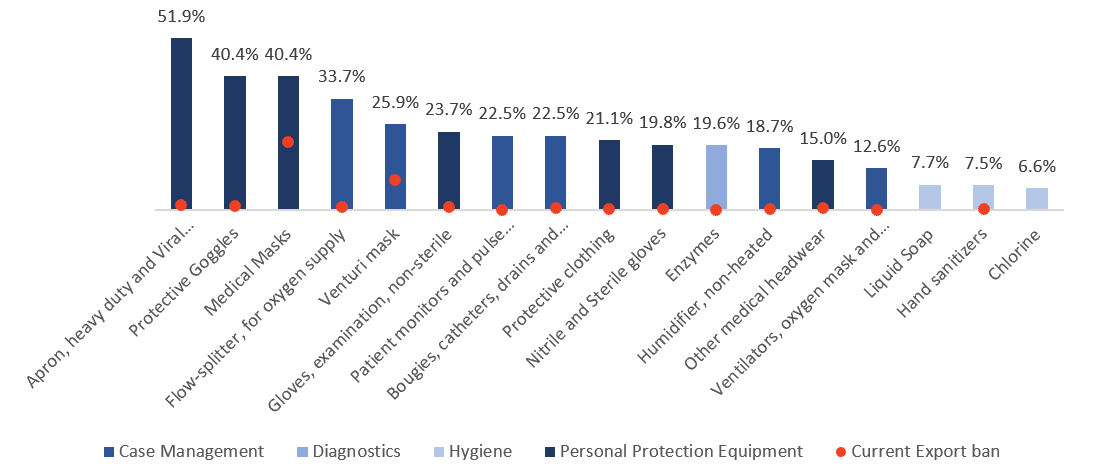 Source: Espitia et al. (2020).
Note: Total imports calculated as the average for 2017, 2018, and 2019 (in case data are available). Direct price effect of export bans calculated using trade elasticities from Fontagne et al.(2019) and assuming a total reduction on export quantities for each trading partner. Direct price effect ij=Var Qij*import price elasticity ij. Where i is the importer and j is the exporter.
Source: Espitia et al. (2020).
Note: Total imports calculated as the average for 2017, 2018, and 2019 (in case data are available). Direct price effect of export bans calculated using trade elasticities from Fontagne et al.(2019) and assuming a total reduction on export quantities for each trading partner. Direct price effect ij=Var Qij*import price elasticity ij. Where i is the importer and j is the exporter.
Import protection contributes to tax the health systems in developing countries
Export policy is only part of the story. Many developing countries tax their own health care systems by imposing tariffs on imports of medical products. Such measures increase the domestic price of essential products, and thus reduce welfare even further. Applied tariffs on key COVID-19 products in the 20 developing countries with the highest number of cases are on average over 6% (Table 2). Personal protection equipment products such as aprons, medical masks and protective clothing are subject to tariffs of over 10%. Severely affected countries such as Iran impose even higher import restrictions of key COVID-19 products, especially for personal protection equipment.
Table 2 Trade-weighted applied tariffs, %
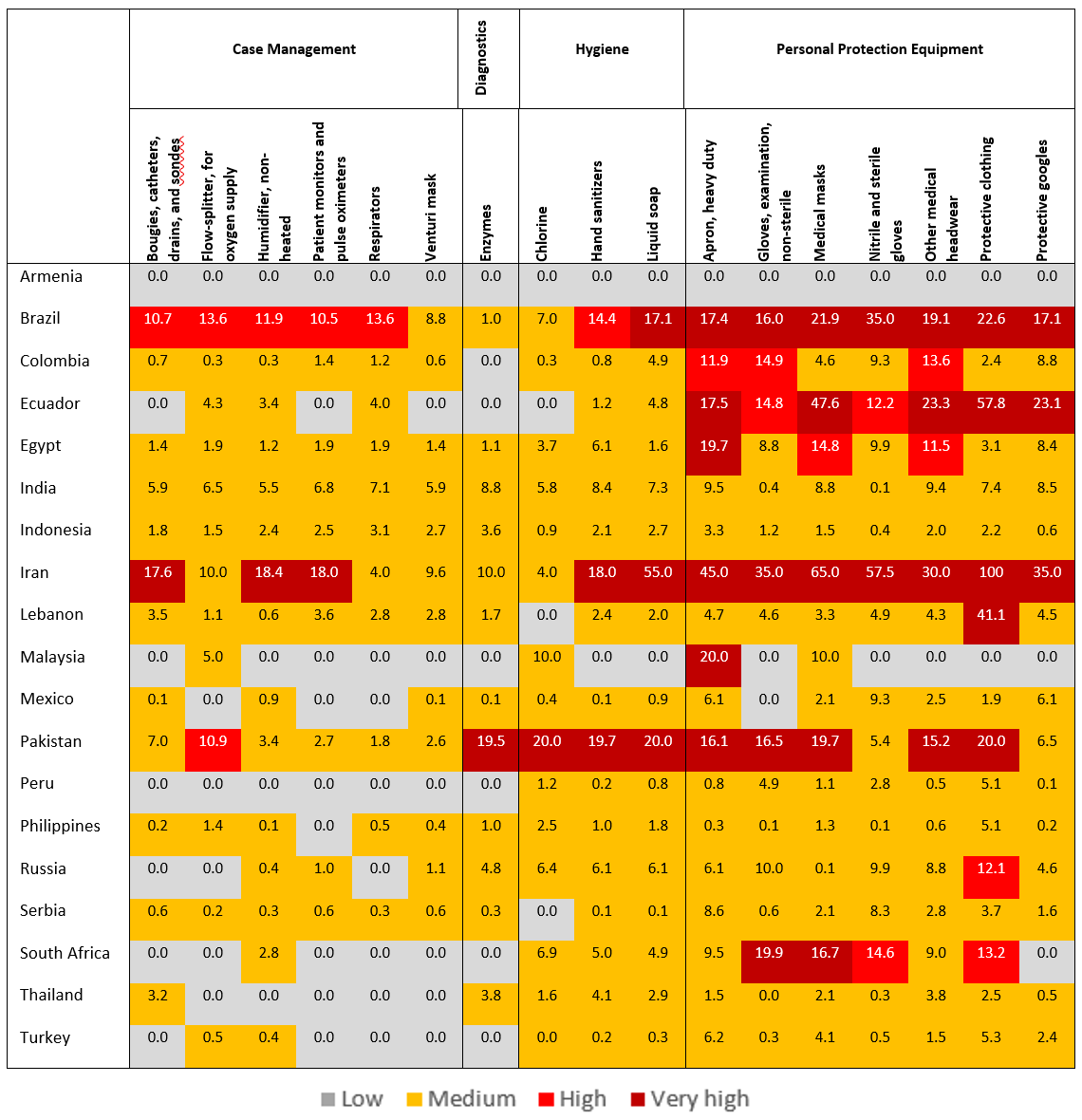 Source: Espitia et al. (2020).
Note: Trade weighted mean of the applied import tariff rate (last year available).
Source: Espitia et al. (2020).
Note: Trade weighted mean of the applied import tariff rate (last year available).
As recent data collected by the Global Trade Alert show, several of the 20 developing countries most affected by COVID-19 have started implementing import reforms in the past days. For instance, Pakistan introduced tax and import duty exemption for medical and testing equipment, while Brazil eliminated tariffs on medical and hospital products. Many of these reforms are on a temporary basis: protection is suspended rather than eliminated. While this is a step in the right direction, exporters might be reluctant to enter markets if they perceive policy changes to be temporary. Locking-in tariff reductions and other policy changes in WTO commitments would be a more effective trade policy reform to address the COVID-19 health crisis.
Trade policy cooperation as part of the solution to the health crisis
To address the crisis, key medical supplies and other crucial COVID-19 products should flow freely from producers to where they are needed.
Export restrictions and import protection are collectively inefficient. For developing countries, as they see the number of COVID-19 cases rise, trade protectionism will cost lives. Trade policy cooperation should first aim at preserving open markets in this difficult time.
Editors’ note: The views expressed in this column are those of the authors and they do not necessarily represent the views of the World Bank Group.
 Source: World Health Organization Coronavirus disease (COVID-2019) situation report – 62 of 22 March 2020 (https://www.who.int/emergencies/diseases/novel-coronavirus-2019/situation-reports)
Source: World Health Organization Coronavirus disease (COVID-2019) situation report – 62 of 22 March 2020 (https://www.who.int/emergencies/diseases/novel-coronavirus-2019/situation-reports)
 Source: Espitia et al. (2020).
Note: Total imports calculated as the average for 2017, 2018, and 2019 (in case data is available). For countries without direct trade data, mirror data are used.
Source: Espitia et al. (2020).
Note: Total imports calculated as the average for 2017, 2018, and 2019 (in case data is available). For countries without direct trade data, mirror data are used.
 Source: Espitia et al. (2020).
Note: Total imports calculated as the average for 2017, 2018, and 2019 (in case data are available).
Export restrictions are also expected to have an impact on world prices (Figure 3). These measures are intended to offset domestic shortages and rising prices as demand for COVID-19 related products surges. But restrictive measures by exporting countries reduce global supply, leading to even higher prices. In the short run, we estimate that current export restrictions could increase prices of medical masks by 20.5% and prices of Venturi masks by 9.1%. Prices of protective equipment such as aprons and gloves are estimated to increase between 1 and 2% due to the current restrictions. Other products could experience smaller increases.
A further concern with export restrictions is that they may be contagious. As prices of key COVID-19 products rise, more governments could respond by imposing export restrictions to mitigate price rises and possible shortages in domestic markets. These actions have aggregate consequences, exacerbating the initial shock and leading to further price escalation -a ‘multiplier effect’ documented in the 2008-11 food crisis (Giordani et al. 2016). If similar dynamics played out for critical COVID-19 products, we estimate that export restrictions will increase prices of COVID-19 relevant goods by 23% on average (Figure 3). The products most affected by price increases would be protection equipment, such as aprons (52% increase) and goggles and masks (40% increase).
Figure 3 Impact of export restrictions on prices (current policies and escalation)
Source: Espitia et al. (2020).
Note: Total imports calculated as the average for 2017, 2018, and 2019 (in case data are available).
Export restrictions are also expected to have an impact on world prices (Figure 3). These measures are intended to offset domestic shortages and rising prices as demand for COVID-19 related products surges. But restrictive measures by exporting countries reduce global supply, leading to even higher prices. In the short run, we estimate that current export restrictions could increase prices of medical masks by 20.5% and prices of Venturi masks by 9.1%. Prices of protective equipment such as aprons and gloves are estimated to increase between 1 and 2% due to the current restrictions. Other products could experience smaller increases.
A further concern with export restrictions is that they may be contagious. As prices of key COVID-19 products rise, more governments could respond by imposing export restrictions to mitigate price rises and possible shortages in domestic markets. These actions have aggregate consequences, exacerbating the initial shock and leading to further price escalation -a ‘multiplier effect’ documented in the 2008-11 food crisis (Giordani et al. 2016). If similar dynamics played out for critical COVID-19 products, we estimate that export restrictions will increase prices of COVID-19 relevant goods by 23% on average (Figure 3). The products most affected by price increases would be protection equipment, such as aprons (52% increase) and goggles and masks (40% increase).
Figure 3 Impact of export restrictions on prices (current policies and escalation)
 Source: Espitia et al. (2020).
Note: Total imports calculated as the average for 2017, 2018, and 2019 (in case data are available). Direct price effect of export bans calculated using trade elasticities from Fontagne et al.(2019) and assuming a total reduction on export quantities for each trading partner. Direct price effect ij=Var Qij*import price elasticity ij. Where i is the importer and j is the exporter.
Source: Espitia et al. (2020).
Note: Total imports calculated as the average for 2017, 2018, and 2019 (in case data are available). Direct price effect of export bans calculated using trade elasticities from Fontagne et al.(2019) and assuming a total reduction on export quantities for each trading partner. Direct price effect ij=Var Qij*import price elasticity ij. Where i is the importer and j is the exporter.
 Source: Espitia et al. (2020).
Note: Trade weighted mean of the applied import tariff rate (last year available).
As recent data collected by the Global Trade Alert show, several of the 20 developing countries most affected by COVID-19 have started implementing import reforms in the past days. For instance, Pakistan introduced tax and import duty exemption for medical and testing equipment, while Brazil eliminated tariffs on medical and hospital products. Many of these reforms are on a temporary basis: protection is suspended rather than eliminated. While this is a step in the right direction, exporters might be reluctant to enter markets if they perceive policy changes to be temporary. Locking-in tariff reductions and other policy changes in WTO commitments would be a more effective trade policy reform to address the COVID-19 health crisis.
Source: Espitia et al. (2020).
Note: Trade weighted mean of the applied import tariff rate (last year available).
As recent data collected by the Global Trade Alert show, several of the 20 developing countries most affected by COVID-19 have started implementing import reforms in the past days. For instance, Pakistan introduced tax and import duty exemption for medical and testing equipment, while Brazil eliminated tariffs on medical and hospital products. Many of these reforms are on a temporary basis: protection is suspended rather than eliminated. While this is a step in the right direction, exporters might be reluctant to enter markets if they perceive policy changes to be temporary. Locking-in tariff reductions and other policy changes in WTO commitments would be a more effective trade policy reform to address the COVID-19 health crisis.




Leave a comment